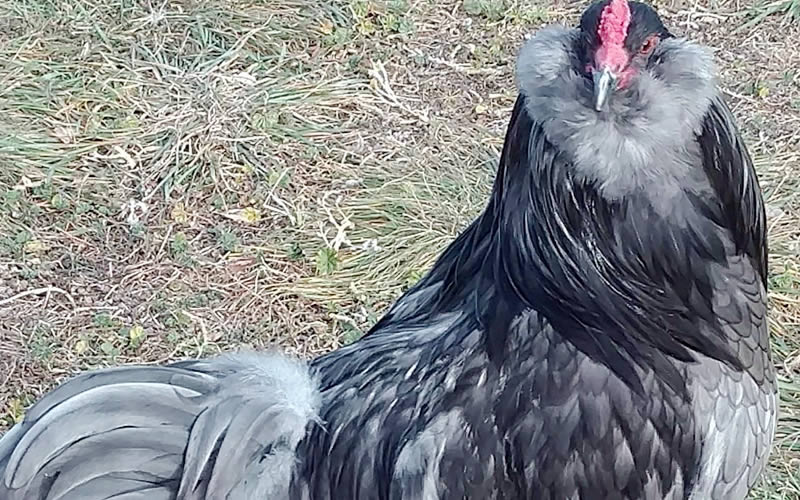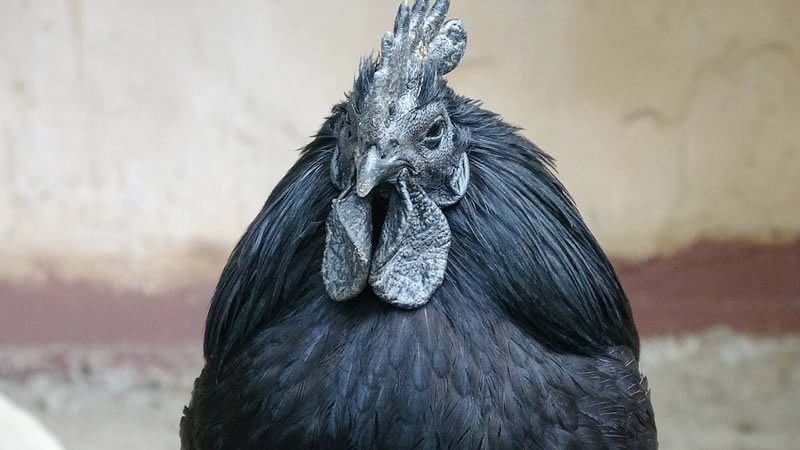
The name Ameraucana sounds patriotic, right? Obviously, this chicken breed originated in the US. And if you are intrigued by their ability to lay blue eggs, well, you are not alone. But can they also be called Easter egg layers? How are Ameraucanas different from Araucanas?
And more importantly, what other interesting characteristics that Ameraucana chickens have?
If you want to know the answers, here’s a complete guide about the Ameraucana chicken breed that has everything you should know.
Table of Contents
- 1 Origin of Ameraucana Chickens
- 2 Ameraucana, Araucana, and Easter Eggers: What’s Their Freakin’ Difference?
- 3 The Appearance of an Ameraucana Chickens
- 4 Average Weight of Ameraucana Chickens
- 5 Ameraucana Chicken Behavior
- 6 Are Ameraucana Chickens Heat Tolerant or Cold Hardy?
- 7 What and How Should You Feed Ameraucana Chickens?
- 8 Ameraucana Chicken Egg Production
- 9 Ameraucana Chicken Meat Production
- 10 Concerns When Raising an Ameraucana Chicken
- 11 Caring and Raising an Ameraucana Chicken
- 12 Ameraucana Chickens Pros and Cons
- 13 Conclusion
Origin of Ameraucana Chickens
First of all, the name Ameraucana is a combination of “America” and “Araucana.” The parent breed of the Ameraucana chicken breed is from Chile but it originated in the US. It started in 1927 when Ward Brower, Jr became curious after he saw a painting of Chilean chickens that laid blue eggs in a copy of The National Geographic Magazine.
Brower, who is from New York, learned that the chicken was a breed raised by the Mapuche, a group of indigenous people in Chile. He also learned that colored eggs were a result of crossbreeding of various breeds and that the blue eggs came from the dominant gene. Nevertheless, he still ordered some Mapuche chickens from Chile.
But when the chickens arrived in 1930, they were not in good condition and some of them eventually died. Fortunately, one of the hens laid light brown eggs before she died. When the male chicks matured, they mate with some hens who later laid cream eggs. During the first year, he noticed that one of the eggs has somehow fainted blue.
Over the years, Brower had crossbred his flock with various breeds. This includes Ancona, Barred Plymouth Rock, Brahma, Cornish, Red Cuban Game, Rhode Island Red, Silver Duckwing Game, Silver Spangled Hamburg, and White and Brown Leghorn. Their eggs resulted in various colors, and that was the start of Easter eggs chickens.
These Easter eggers were used to being referred to as Araucanas, the parent breed of the Ameraucanas. Various breeders have proposed many different standards of the Araucana chicken breed to the American Poultry Association (APA). So in 1976, the APA has decided that Ameraucana and Araucana are two different chicken breeds.
However, the descriptions of Araucana chickens are different if you are in the UK, Australia, and some other countries. You will be told that both the tailed and tailless variants of the Araucana belong to a single breed. In some cases, they also consider the muffed and bearded varieties as Araucanas. Sounds confusing, right?
Ameraucana, Araucana, and Easter Eggers: What’s Their Freakin’ Difference?
Are you still confused with Ameraucana, Araucana, and Easter eggers? Don’t worry, you are not alone. In fact, a lot of beginners became victims of unscrupulous sellers because of misinformation or propaganda surrounding these three terms. To help you understand more about them, here are some myths and facts you should know:
Myths
- Ameraucanas should have muffs and beards. Araucanas are native Chilean chickens.
- Araucanas are the original layers of blue eggs.
- Araucanas should have ear tufts and have no tails (rumpless).
- All Easter eggers came from Ameraucanas and Araucanas.
Facts:
- Araucanas are very rare in the US because of their genetic disorders.
- The Collonca chickens (the origin of Araucanas) were the first blue-egg layers.
- “True” Ameraucanas are only available from reputable breeders.
- Not all Ameraucanas sold at hatcheries are Easter eggers.
- Some Easter eggers may not lay blue eggs.
- Ameraucanas were not bred from the current Araucanas. In fact, both of them were developed simultaneously.
You should also understand that the Araucana breed is the result of crossing the Collonca and Quetro breeds. Although both of them were from Northern Chile, they have major differences. Collonca chickens have no ear tufts and tails but they lay blue eggs. On the other hand, Quetro chickens have ear tufts and tails but they don’t lay blue eggs.
Meanwhile, the first and original Ameraucana chickens were bred by the Ameraucana Bantam Club (ABC), a group formed by Mike Gilbert from Iowa, Don Cable from California, and other breeders. It all started when Mike bought some Bantam Easter eggers from a hatchery in Missouri. He was able to develop the American Araucana.
These bantam chickens were Wheaten Ameraucana, which has beard, muff, and tails, and can lay blue eggs. After a photo was published at Poultry Press in 1977, Don saw it and coordinated with Mike along with some other breeders. The American Bantam Association (ABA) decided to recognize the Ameraucana bantams in 1980.
Later, the ABC became the Ameraucana Breeders Club and the Ameraucana Alliance. They started to develop the Ameraucana large fowl and became successful.
The Ameraucana breed was added to APA’s Standard of Perfection in 1984 and nine color varieties of both the large fowls and bantams were recognized. They are:
- Black
- Blue
- Blue Wheaten
- Brown Red
- Buff
- Silver
- Wheaten
- White
In 2020, the APA has also decided to recognize the Self Blue (Lavender) variety but only for large fowls.
The Appearance of an Ameraucana Chickens

As mentioned above, Ameraucana chickens have beard and muff feathers, and a medium-length tail. But just to clarify things, some of them may be born without a beard and a muff. Although they might not qualify to appear at bird shows or exhibitions as Ameraucanas, they may still be Ameraucanas. They are also dubbed as “clean-faced.”
Ameraucana chickens also have reddish-brown eyes, a small triple-ridged pea comb, and the bottoms of their feet and toes are white. They may have small wattles or none at all. They also have small, bright red ear lobes that are covered with feathered muffs.
All Ameraucana varieties except for Black and White have horn to dark horn beaks. Black Ameraucanas have black beaks while White Ameraucanas have light horn beaks. On the other hand, all of them have slate blue-colored shanks except for the Black variety that has dark slate to black legs. Nevertheless, all of them have white skin.
Ameraucanas have full and trimmed bodies, broad chests, and semi-curved beaks. Their necks are medium-sized that are covered with thick layers of feathers, while their tail is carried out to their body at an angle of around 45 degrees. They have prominent heavily-feathered wings but without feathers on their legs and feet. Each foot has four toes.
Average Weight of Ameraucana Chickens
Large fowl roosters weigh about 6.5 pounds while their hens weigh about 5.5 pounds. Their cockerels weigh about the same as hens, while pullets weigh about 4.5 pounds. For their bantam version, roosters weigh around 1.875 pounds while hens weigh around 1.625 pounds. Their cockerels weigh around 1.625 pounds while pullets weigh around 1.5 pounds.
Ameraucana Chicken Behavior

The temperament of Ameraucana chickens mainly depends on their strain. But in general, they are docile, smart, and intelligent birds. Some of them are very friendly but some don’t want to be touched or cuddled. Although they are not really aggressive, some of them can be flighty or can easily get scared and will fly away.
Ameraucanas are very curious, active, and are good foragers. They also do well in both confinement and free-range but they prefer larger spaces. These blue-egg layers are also sociable with other breeds but some may be hostile. In short, they may be in the low or the middle of the pecking order. Nevertheless, they can fight against predators.
In general, Ameraucanas can be family pets. Although they are not aggressive, you should still be careful if you have small children. Ameraucana hens are also noisy but tolerable, especially when they are about to lay eggs, during and after laying eggs. The white hens are usually the quietest, while the silver variety is usually the hostile type.
Ameraucana hens are not considered broody. But when they do, it does not usually take long. If they were bred for egg production, they could be less broody. Broody hens are also easier to break as compared to other breeds. Nevertheless, they can be very devoted mothers. In short, it’s quite hard to determine the level of their broodiness.
Are Ameraucana Chickens Heat Tolerant or Cold Hardy?
Ameraucana chickens tend to do well in both hot and cold weather. They may not be able to tolerate summer that much but they can still handle the heat are not prone to heatstroke. On the other hand, they are a bit better during winter. Thanks to their small pea combs and very small (or absent) wattles, they are very unlikely to have frostbite.
What and How Should You Feed Ameraucana Chickens?
Ameraucana chickens are not difficult to feed and they eat anything that touches their beaks. Just like other breeds, baby chicks should be fed with starter feed, followed by grower feed. Once they start laying eggs, you should switch them to layer feed. You must also give them some fruits, vegetables, and grains, and course, a good supply of clean and fresh water.
Ameraucana Chicken Egg Production

Ameraucana hens have different egg-laying abilities, depending on their strain. But on average, they may start laying eggs once they reach 5 months (15 weeks) of age. Some of them may start at 10 months old and that’s perfectly normal. They lay between 100 and 250 eggs a year, or 2 to 5 eggs a week. Some strains still lay eggs during winter.
Ameraucana eggs can also be medium-sized or large, depending on their strain. Aside from blue eggs, Ameraucana can also lay blue-green eggs as well as light blue and khaki. But again, not all hatchery chicks are “true” Ameraucanas. They are usually Easter eggers that can also lay blue eggs and other colors. So again, don’t be fooled.
On the other hand, if you are sure that you have “true” Ameraucana chicks because you bought them from a reputable breeder, it does not necessarily mean they will always lay blue eggs. In some cases, Ameraucana hens that are on their later egg-laying season will start laying light-colored eggs instead of blue. But don’t worry; it’s part of their cycle.
Ameraucana Chicken Meat Production

Ameraucana chickens are classified as dual-purpose, which means they are also good for meat production. But because they are more of backyard chickens, you might not have the heart to slaughter them. Nevertheless, their meat is tasty and can make a great chicken soup. However, Ameraucanas may not that big enough for a hungry family.
Concerns When Raising an Ameraucana Chicken
Unfortunately, some strains of Ameraucana chickens are prone to having cross beaks as compared to most breeds. This is a genetic condition wherein the upper and lower beaks are not properly aligned due to skull deformation. Therefore, the affected birds will have a hard time eating and you will need lots of effort to keep them healthy.
So far, there’s no scientific study that explains its cause and there’s no cure for them. Another challenge for them is during colder months because their muffs and beard might get wet while they are drinking. In some cases, cross beaks can be detected right after they are hatched. However, some of them only show signs while they are growing.
Caring and Raising an Ameraucana Chicken
Ameraucana chickens are not really difficult to take care of unless they have cross beaks. They are also not prone to heatstroke and frostbite which means they don’t need extra care during summer and winter. But just like other breeds, they might encounter internal and external parasites such as lice and mites if they are living in an unhealthy environment.
Ameraucanas may not be that big but because they are active chickens, they need more space. Some strains are also in the middle of the pecking order and tend to be bossy which means you should not mix them with aggressive breeds. They also fly high especially when they are scared so you might want to build higher fences in your backyard.
Ameraucana Chickens Pros and Cons
At this point, you probably agree that Ameraucana chickens are very controversial and intriguing, especially about their ability to lay blue eggs. Now, it’s time to summarize their pros and cons.
Advantages of Raising Ameraucana Chickens
- Prolific layers of blue eggs
- Great egg layers
- Good for meat production
- Active, curious, and adventurous
- Good foragers and highly independent
- Smart and intelligent
- Adaptable to confinement and free-range
- Noisy but tolerable
- Very cold hardy
- Can handle hotter months
- Can fight against predators
- Available in various color varieties
- Bantams have the same color variations as large fowls
- Manageable for beginners
Disadvantages of Raising Ameraucana Chickens
- True Ameraucanas are quite hard to find
- Not all strains can be held by small children
- Behaviors mainly depend on the strain
- Some strains have genetic disorders (cross beaks)
- Inconsistency in broodiness
Conclusion
Generally speaking, Ameraucana chickens are interesting to breed especially if you love blue eggs. Aside from the possibility of having chicks with cross beaks, the next challenge is to make sure you are buying only the “true” Ameraucanas. This is why you must know the facts so you won’t be fooled by wrong information.






